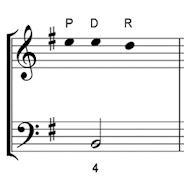Step 1. Dissonances
When we tackle a grade 8 Trio Sonata question, we should begin with the dissonances because the treatment of dissonance in the Baroque era was strict, which means we have very little choice about which notes to pick. We need to begin with the least flexible parts of the question, and gradually work towards the most flexible parts.
- Identify the dissonant note
Baroque dissonances are added 7th chords, added 9th chords, and suspensions, so we are looking at these figures:
- 7, 6/5, 4/3, 4/2 (added 7th chords)
- 9 (added 9th chord)
- 4-3, 9-8, 7-6 (suspensions)
- 4 (suspended 4th moving to a first inversion chord)
In added 7th chords, it is the note which forms a dissonant 7th interval with the root (not necessarily the bass note) that needs special treatment.
- In 7, it is the 7th above the bass.
- In 6/5, it is the 5th above the bass.
- In 4/3, it is the 3rd above the bass.
- In 4/2 it is the bass note itself.
For example, in C major, V7 is G7, with F as the dissonant 7th above G. Notice the position of F in relation to the bass note of each chord, as the inversions change:

You need to remember that the dissonant note is the 7, the 5 (lower note in the figure), or the 3 (lower note in the figure).
You do not need to worry about 4/2 chords, because the dissonance is in the bass line, which is already written out for you.
- In all the other figures, it is the 4, 7 or 9 which is the dissonant note above the bass.
- Preparation, Dissonance, Resolution
All dissonances should be prepared and resolved. (In rare cases it may be impossible to prepare or resolve, but if it is possible, it must be done).
This means for each dissonant note, you can write in three melody notes (the preparation, the dissonance itself, and the resolution).
- Preparation means using the dissonant note in the previous chord, in the same part.
- Resolution means moving by a step downwards in the following chord, in the same part.
For example, with this bass note B, figure 4, the dissonant note is E (a 4th above B).

We should write an E directly above the B (this is the 4th, the dissonance), another E before it, (this is the preparation), and a D after it (this is the resolution).

If possible, write the three notes in the correct upper part (keep the parts moving smoothly). Just add the note heads, as you will decide on the rhythm later.
If it is not yet clear which is the correct upper part, pencil the notes lightly above the bass line for the moment.